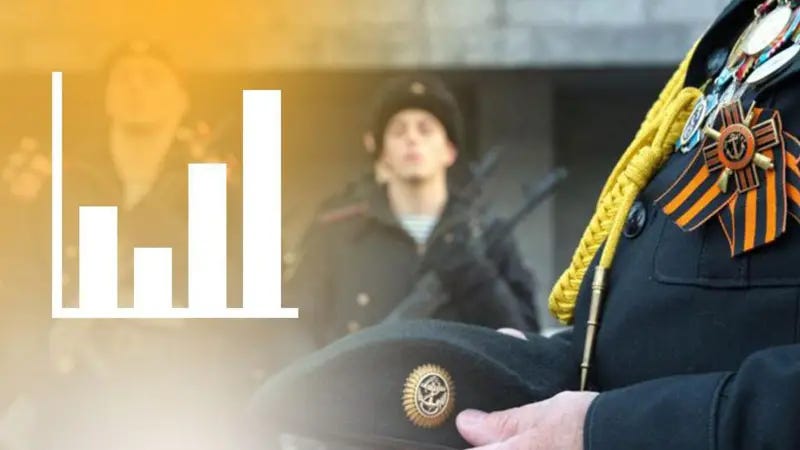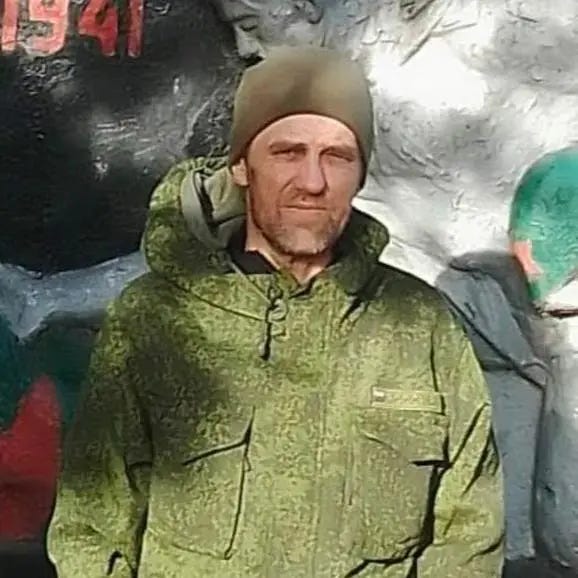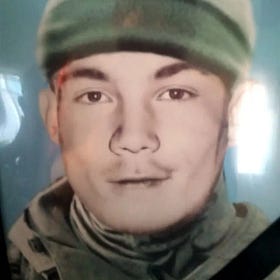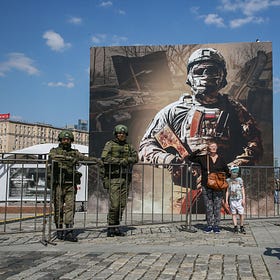Almost 135,000 killed? Working out Russia’s war dead in Ukraine
New Russian army recruits are being tempted by ever-increasing ‘golden handshakes’ – and make up a rapidly growing proportion of those killed at the front in Ukraine.
By Olga Ivshina and Yaroslava Kiryukhina.
BBC Russian, in association with Mediazona and a team of volunteers, has analysed open source information to establish the names of 61,009 Russian soldiers killed in the full-scale invasion of Ukraine. Almost half of them – at least 48% - had no affiliation with the Russian armed forces at the time the fighting began.
Real losses are obviously much higher than we can establish through open sources. Military specialists suggest our analysis of Russian cemeteries, war memorials and obituaries captures 55-70% of the true death figure – suggesting that losses range from 87,140 to 110,900 men killed in action.
The numbers increase sharply if we included deaths in the so-called ‘people’s militias’ of the self-proclaimed Donetsk and Luhansk People’s Republics. Their data is either no longer published or was never published in the first place, but obituaries and reports of searches for men missing in action lead us to conclude the Donbas units have lost 20,000-23,500 men.
That brings the total death count on the Russian side to between 107,140 and 134,400 troops killed in the war.
In the case of 28% of the dead, we were unable to determine what military branch they had served with. The obituaries of these men were generally accompanied by photos of them in civilian clothing.
In reality, it may be that as many as 70% of Russian combat losses are among those who were recruited into the military after the war started.
This is the backdrop against which the authorities are intensifying a push to attract new recruits to the army. The BBC’s calculations suggest that 10 regions have significantly boosted signing-on payments for new contracts this month.
Alexander Kravtsov, from the village of Sharaldai in Buryatia, was drafted into the Russian army on graduation from the vocational technical school he entered after ninth grade. Various kinds of shift work followed, his obituary states, before he decided to sign a one-year contract beginning on November 16th last year as a volunteer in zone of the Special Military Operation.
Kravtsov’s story reflects several important trends. First, that the majority of volunteers are coming from small settlements in parts of Russia where it is hard to find well-paid, full-time work.
Second, many volunteers sign a one-year contract in the belief that they can go back to civilian life when the 12 months are up. But the reality is very different.
‘For those living in their rosy world, Ministry of Defence contracts are automatically extended for the duration of the Special Military Operation. This is a decree!’ snapped ‘Z-blogger’ Anastasia Kashevarova, in response to the latest batch of enquiries from soldiers who wanted to come home after a year’s service on their contract.
“This is not a new development; contracts have been extended since September 2022! Mobilised soldiers serve until the end of the Special Military Operation. So, guys, take off your rose-tinted glasses. Read what you are signing."

We have seen a sharp, significant increase in the number of volunteers killed since October last year, when they have not fallen below 100 men a week, and sometimes exceeded 240 a week. These soldiers make up the fastest growing category of losses in our calculations.
Open source information suggests that in the first six months of this year, Russia lost at least 11,210 men at the front. By comparison, we managed to establish the death of 7,804 fighters in the first six months of the invasion in 2022.
The exact number of casualties for the first half of 2024 is much higher than our figure. News from the battle zone arrives after long delays, and it takes time to process it. So the figures for the last few weeks are not complete and may be much bigger in reality.
In general, the number of losses we have accounted for over the winter and spring of this year were exceeded only by those recorded during the famously bloody assault on Bakhmut in 2023.
The race of the regions
Russia’s regions have increasingly started raising the sign-on bonus for new army contracts. Our estimations show that in 2024, a third of regional administrations have boosted the payment or promised to do so.
Krasnodar raised the bonus three times so far this year, and Chelyabinsk twice. Both are among the leaders in total numbers of casualties at war. The overall distribution of losses, taking into account the density of the male population, is as follows:
Novaya Gazeta Europe has worked out that over the more than two years since the invasion began, the average regional payment for new contract soldiers has risen 80 times. This trend, along with statements by officials, suggest a top-down programme for recruiting in the regions, with men tempted by social benefits and salaries that are on average 5-7 times higher than the local average.
On June 10th, a new record was set by Karachay-Cherkessia, which raised the payment to 1,305,000 rubles – or $14,720. Karachay-Cherkessia, along with Ingushetia, are among the most impoverished regions of the country.
Obituaries of dead soldiers analysed by the BBC show that many hundreds of volunteers to the army over the past 12 months were sent to the front within 10-14 days of signing the contract. This significantly reduces the chances of survival on the battlefield.
General trends
15% of confirmed casualties in the war to date were volunteers, meaning they joined the armed forces from civilian life after the start of the invasion and signed a contract voluntarily. By comparison, 12.5% of the dead were mobilised men.
But the proportion of volunteers among the dead rises steeply - to at least 30% - when one considers confirmed casualties since October 2023.
The true number of casualties among both the mobilised and volunteers is higher than the figures we can provide; largely because officials now offer far fewer details about the dead than at the start of the war.
The obituaries of those who died at the front in 2023-2024 are generally accompanied by photographs of them in civilian clothing or uniforms without insignia, meaning we increasingly have to categorise them as ‘data unavailable’.
The largest contingent among the dead remains prisoners who joined the war from penal colonies. They account for 20% of confirmed killed. The majority of them fought with the Wagner private military company and died in 2022-2023. Prisoners fighting in defence ministry units are being killed at a slower rate.
A number of men facing criminal prosecution have been able to sign an army contract to go to the front before sentencing. These cases we categorise as ‘volunteers’.
Special forces and paratroopers who survived the first year of the war being held back and protected by the military command, and used only to hold positions or for selected special operations. High-value men only engage in offensive missions in specific, favourable circumstances.
Russia has lost 3,725 officers in Ukraine since the invasion, with 444 holding the rank of lieutenant colonel or higher. These figures represent names we have confirmed – the true number of officers killed is of course markedly higher.
250 pilots, who represent the elite of any military, have also been lost in action.
President Putin promised that draftees would not participate in combat operations, but we have identified 121 conscripts who have died in Ukraine since the invasion. Many died in the border areas of Russia’s Belgorod region, guarding the frontier and technically not taking part in the war. But in reality, men who were recently schoolboys were exposed on a daily basis to shelling and small arms fire, holding positions that ordinarily would be defended by professional units.
Since the start of the full-scale invasion, Russia has lost at least 1,426 soldiers aged 20 or younger. A few days ago, another soldier born in 2006 was confirmed killed: Yaroslav Lipavsky from Tyumen signed his contract on March 18th, two days after his 18th birthday.
It is likely that he is the same Yaroslav Lipavsky who had stood trial in the city shortly beforehand on charges of intentional grievous bodily harm. Court records state that the trial was closed on March 27th because of ‘a lack of physical opportunity for the accused to participate’ in the hearing.
Lipavsky survived less than two weeks at the front line.
Our method
New names of the dead and photographs from funerals are published every day throughout Russia. Their identities are disclosed by the heads of Russia’s regions, representatives of district administrations, local media, educational institutions where the deceased had studied, or by relatives.
BBC Russian, Mediazona, and a team of volunteers examine this information and add it to the database we have been compiling since the start of Russia’s full-scale invasion of Ukraine. We consider death confirmed if its announced by an official Russian source or the Russian media, or if it is made public by relatives. Other sources are also counted if they are accompanied by photos of the funeral.
Generally we do not include losses by the DNR and LNR “republics”, though if a Russian citizen has volunteered to go to war for such units, we do count him.
The kind of military unit concerned is determined either by reports of where the deceased served or by the insignia on his uniform. While conscripts, volunteers and convicts are not separate types of troops, we categorise them independently in order to compare losses against those borne by professional fighting units of the regular army.
The category “Other troops” in our graphics covers air defence servicemen, Nuclear Biological and Chemical troops, communications specialists, air force ground troops, Interior Ministry servicemen, transport troops and the military police.
Read this story in Russian here.
English version edited by Chris Booth.
Everyone’s at the front line. Penal colonies in Russia are closing down: there’s nobody left to ‘do the time’
The war in Ukraine has seen tens of thousands of Russian prisoners recruited to the battlefields.
Counting Russia's lost troops in Ukraine: stories of desperate families
BBC Russian's Olga Ivshina talks to BBC World Service radio about her ongoing project to count how many Russian soldiers are dying in Ukraine, and what it means for their families.













The average wages in Rural Russia are so much lower than I had assumed, even though I have no respect for that terribly run country
What a pathetic loser country that is
Thank you for doing this painstaking, impressive work. A colleague.